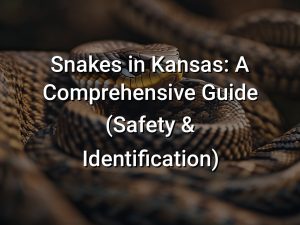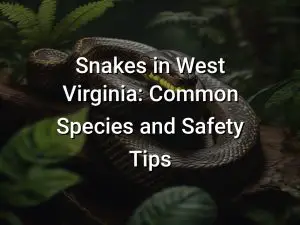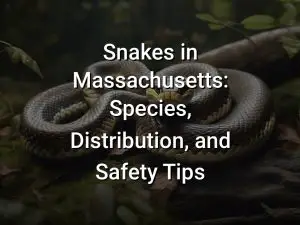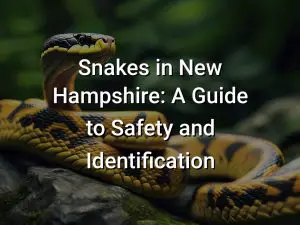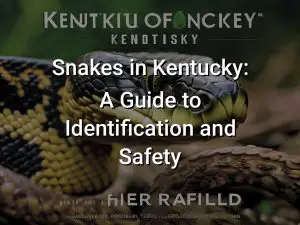Snakes in Louisiana: A Comprehensive Guide (2023)
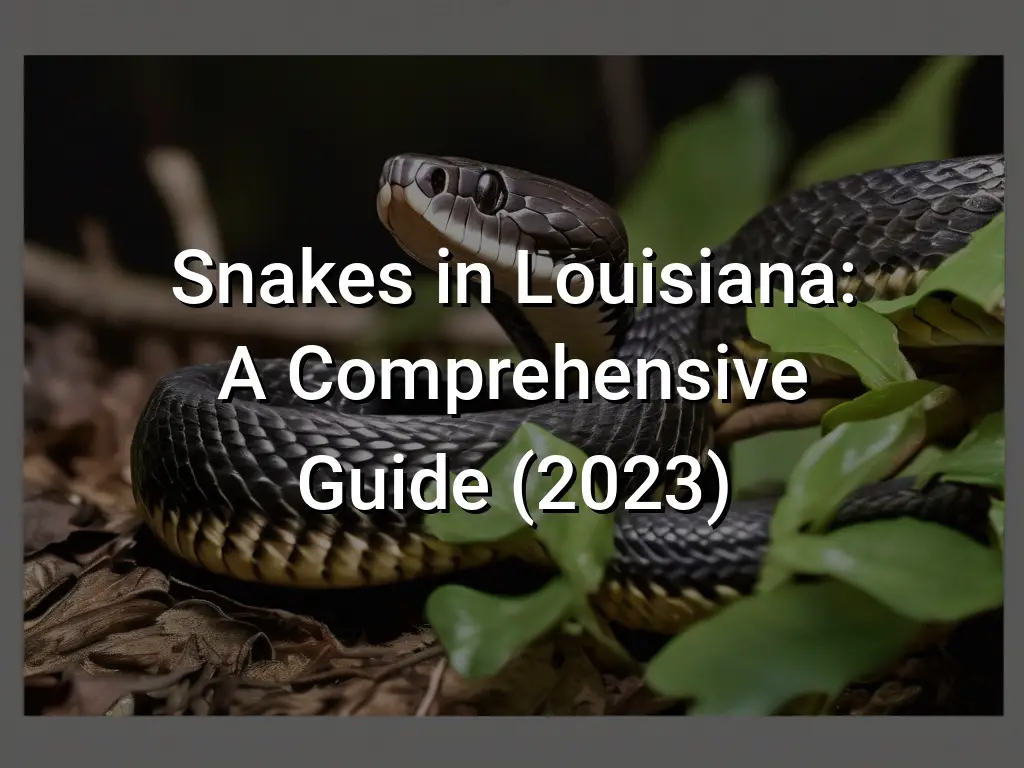
If you’re a fan of snakes or simply want to learn more about them, you’re in for a slithering treat! Louisiana, known for its rich wildlife and diverse ecosystems, is home to a variety of snake species, both venomous and non-venomous. From the intimidating Eastern Diamondback Rattlesnake to the elusive Louisiana Pine Snake, this comprehensive guide will introduce you to the fascinating world of snakes in the Bayou State.
Whether you’re a nature enthusiast, a student studying herpetology, or a curious individual, this article will provide valuable information about the different snake species found in Louisiana. From their physical characteristics to their habitats and behaviors, we’ll delve into the unique features and traits of each snake, so you can gain a deeper understanding and appreciation for these remarkable creatures.
Quick Links
Venomous Snakes
Louisiana is home to several species of venomous snakes, each with its own unique characteristics and behaviors. It is important to be aware of these snakes and exercise caution when encountering them.
Cottonmouth: Also known as the Water Moccasin, the Cottonmouth is a venomous pit viper found in Louisiana’s swamps, marshes, and lakes. It is known for its distinctive white mouth, which it displays as a warning when threatened. The venom of the Cottonmouth is hemotoxic and can cause tissue damage and internal bleeding.
Eastern Diamondback Rattlesnake: The Eastern Diamondback Rattlesnake is the largest venomous snake in North America and can be found in the southern parts of Louisiana. It has a distinct diamond pattern on its back and a rattle on its tail. The venom of the Eastern Diamondback Rattlesnake is highly potent and can cause severe symptoms, including tissue damage and organ failure.
Copperhead: The Copperhead is a venomous snake with a distinctive copper-colored head. It is primarily found in forested areas of Louisiana. Although its venom is less potent compared to other venomous snakes, a bite from a Copperhead can still cause pain, swelling, and other symptoms.
It is important to remember that these snakes do not go out of their way to attack humans and will usually only bite if they feel threatened or cornered. If you encounter a venomous snake, it is best to give it a wide berth and leave it alone. If bitten, seek medical attention immediately as venomous snake bites can be dangerous.
Non-venomous Snakes
Louisiana is home to a variety of non-venomous snakes that play important roles in the ecosystem. These snakes are harmless to humans and can be found in various habitats, such as forests, wetlands, and gardens.
1. Louisiana Pine Snake: The Louisiana Pine Snake is a large, non-venomous snake that is native to the pine forests of Louisiana. It is known for its vibrant yellow coloration and black blotches. This snake is considered rare and is listed as a threatened species.
2. Rat Snake: Rat snakes are common in Louisiana and are often found near human habitats. They are excellent climbers and can be beneficial to have around as they feed on rodents, including rats and mice.
3. Coachwhip Snake: The Coachwhip snake is known for its extremely fast and agile movements. It is a non-venomous snake with a slender body and is typically brown, black, or reddish in color. These snakes are highly alert and tend to flee when encountering humans.
4. Speckled Kingsnake: The Speckled Kingsnake is a non-venomous snake that gets its name from the speckled pattern on its body. It is known for its ability to eat venomous snakes, making it a valuable species for controlling snake populations in Louisiana.
5. Scarlet Snake: The Scarlet Snake is a small, non-venomous snake that is often mistaken for the venomous coral snake due to its similar color pattern of red, black, and yellow bands. However, the Scarlet Snake’s red and black bands touch, while the bands of the coral snake do not.
These non-venomous snakes in Louisiana are important members of the ecosystem and contribute to the overall balance of the environment. It is always important to remember that snakes play a vital role in the ecosystem and should be respected and left undisturbed whenever possible.
Louisiana Pine Snake
The Louisiana Pine Snake (Pituophis ruthveni) is a non-venomous snake species native to the southeastern United States, primarily found in Louisiana. It is a large and impressive snake, reaching lengths of up to 6 feet.
The Louisiana Pine Snake has a unique appearance with a distinct pattern of dark brown or black blotches on a light brown background. These blotches often form a rectangular shape along the length of the snake’s body, giving it a stunning and eye-catching appearance.
This species is primarily found in the longleaf pine forests of Louisiana, as well as in parts of Texas and Mississippi. It prefers open, sandy areas with sparse vegetation, such as pine savannas and pine flatwoods.
The Louisiana Pine Snake is a docile and generally non-aggressive species. It is mostly active during the day and primarily feeds on small mammals, such as mice and rats, as well as birds and their eggs. Due to its habitat preferences and specialized diet, this species is considered threatened and is protected by state and federal regulations.
Conservation efforts are underway to protect the Louisiana Pine Snake and its habitat. These efforts include habitat restoration, controlled burns to maintain suitable habitat conditions, and educational outreach to raise awareness about the importance of preserving this species.
If you encounter a Louisiana Pine Snake in the wild, it is best to observe it from a distance and avoid disturbing or handling it. It is important to respect and protect these fascinating creatures and their natural habitats.
Cottonmouth
The Cottonmouth, also known as the Water Moccasin, is a venomous snake species commonly found in Louisiana. It is one of the most feared and misunderstood snakes in the region.
The Cottonmouth is named for the distinctive white coloration inside its mouth, which it displays as a warning when threatened. It has a thick body and a dark, almost black, coloration, which provides excellent camouflage in swamps, marshes, and other aquatic habitats where it is commonly found.
As a venomous snake, the Cottonmouth possesses potent venom that it delivers through its long, hollow fangs. Its venom is hemotoxic, meaning it causes damage to blood vessels and surrounding tissue. Bites from the Cottonmouth can be dangerous and should be treated as a medical emergency.
Despite its reputation, the Cottonmouth is not an aggressive snake and will generally only bite if it feels threatened or cornered. It typically prefers to avoid confrontation and will often try to escape when encountered by humans.
When it comes to diet, the Cottonmouth is an opportunistic feeder and will consume a variety of prey, including fish, amphibians, reptiles, birds, and small mammals. It hunts both on land and in water, using its heat-sensing pits to detect prey, and its venom to incapacitate and kill.
Being a semi-aquatic species, the Cottonmouth is commonly found near bodies of water such as swamps, lakes, rivers, and marshes. It is a good swimmer and can even remain submerged for extended periods of time.
While the Cottonmouth can be dangerous, it plays an important role in its ecosystem by helping to control populations of rodents and other small animals. It is protected by state law in Louisiana and should be respected and observed from a safe distance in its natural habitat.
Eastern Diamondback Rattlesnake
The Eastern Diamondback Rattlesnake is one of the most famous and venomous snakes found in Louisiana. It is the largest venomous snake in North America and can grow up to 8 feet in length. As the name suggests, this species has a distinctive diamond-shaped pattern on its back and a rattle at the end of its tail.
The Eastern Diamondback Rattlesnake primarily inhabits pine forests, swamps, and marshes in Louisiana. It is known for its ambush hunting style, patiently waiting for its prey to come close before striking. Its diet consists mainly of small mammals, such as rats, rabbits, and squirrels.
Like all rattlesnakes, the Eastern Diamondback has venomous fangs that it uses to inject venom into its prey. The venom is potent and can lead to severe pain, swelling, and tissue damage. If bitten by an Eastern Diamondback Rattlesnake, it is essential to seek immediate medical attention.
This species plays a crucial role in the ecosystem as an apex predator, helping to control the population of smaller mammals. However, due to habitat loss and human activities, the Eastern Diamondback Rattlesnake is considered a threatened species in some areas.
When encountering an Eastern Diamondback Rattlesnake in Louisiana, it is important to exercise caution and give the snake plenty of space. These snakes generally avoid human interaction but may become defensive if they feel threatened. It is always best to observe snakes from a distance and avoid any unnecessary risks.
Copperhead
The copperhead snake is one of the venomous snakes found in Louisiana. It is named for its coppery-red or reddish-brown colored head. The rest of its body is typically light brown with darker bands or patches.
Copperheads are relatively small snakes, averaging around 2-3 feet in length, although some can grow up to 4-5 feet. They have a stout body and a triangular-shaped head with distinctive facial pits on either side of their snout, which help them detect prey.
Copperheads are mainly found in wooded areas, swamps, and marshes, where they can blend in with their surroundings. They are generally not aggressive and will try to avoid human encounters. However, they can become defensive and may bite if they feel threatened or cornered.
The venom of a copperhead snake is considered mild compared to some other venomous snakes. Copperhead bites are rarely fatal but can cause significant pain, swelling, and tissue damage. If bitten by a copperhead, it is important to seek medical attention immediately.
As with all venomous snakes, it is crucial to exercise caution and give them space when encountered in the wild. If you come across a copperhead snake, it is best to back away slowly and leave it undisturbed.
It is important to remember that although copperheads are venomous, they play a role in the ecosystem by controlling rodent populations. It is always best to appreciate snakes from a safe distance and respect their place in nature.
Rat Snake
The Rat Snake is a common non-venomous snake found in Louisiana. It is known for its slender body, which can grow up to 6 feet in length, and its smooth scales. Rat Snakes come in a variety of colors, including yellow, brown, and black, with some individuals having distinct patterns or markings.
These snakes are excellent climbers and can often be found in trees or other elevated areas. They are also proficient swimmers and can be found near bodies of water, such as rivers, lakes, and marshes.
Rat Snakes are opportunistic feeders and have a diverse diet. They primarily consume small mammals, such as rats, mice, and squirrels, but they may also eat birds, eggs, frogs, and insects. They are constrictors, meaning they squeeze their prey to subdue and kill it before swallowing it whole.
When threatened, Rat Snakes will often mimic venomous snakes by vibrating their tails, hissing, and flattening their heads. However, they are harmless to humans and pose no significant danger. If encountered, it is best to leave them alone and allow them to continue on their way.
These snakes play an essential role in controlling rodent populations and maintaining a balanced ecosystem. They are a valuable part of Louisiana’s wildlife and should be appreciated and respected.
Coachwhip Snake
The Coachwhip snake, scientifically known as Masticophis flagellum, is a non-venomous snake species found in Louisiana. It gets its name from its long, slender body, which resembles a braided coachwhip. These snakes can grow up to 6 to 8 feet in length.
Coachwhip snakes are known for their speed and agility. They are excellent climbers and are often found in trees and shrubs. Their color can vary from light brown or tan to reddish-brown or dark brown. They have a slender head and sharp, pointed snout.
These snakes are diurnal, meaning they are active during the day. They are also highly territorial and can defend their territory aggressively. Coachwhips primarily feed on small mammals, birds, lizards, and other snakes.
Although coachwhip snakes are non-venomous, they are known to be extremely fast and agile when it comes to hunting prey or escaping predators. When threatened, they may exhibit defensive behavior such as coil their bodies, hissing, or striking, although they rarely bite humans.
Coachwhip snakes play an important role in maintaining the balance of ecosystems by controlling populations of small mammals and reptiles. They are fascinating creatures to observe, but it’s important to remember to admire them from a distance and not disturb their natural habitats.
Speckled Kingsnake
The Speckled Kingsnake, also known as the Appalachian Kingsnake, is a non-venomous snake species found in Louisiana. It is known for its distinct appearance and behavior.
The Speckled Kingsnake has a black or dark brown body with yellow or white speckles, giving it a speckled or mottled appearance. It can grow up to 4 to 5 feet in length and has a relatively slender body.
This snake species is found in a variety of habitats, including forests, grasslands, and swamps. It is often seen near water sources and retreating to underground burrows or logs for shelter.
The Speckled Kingsnake is a constrictor and feeds primarily on rodents, such as mice and rats. It is also known to eat other small vertebrates, including lizards and birds.
Despite its name, the Speckled Kingsnake is not harmful to humans. It plays an important role in controlling rodent populations and is generally docile and shy. It will only bite if threatened or provoked.
If you encounter a Speckled Kingsnake in the wild, it is best to admire it from a distance and avoid disturbing or handling it. It is a beneficial snake species that helps maintain the balance of ecosystems in Louisiana.
Scarlet Snake
The Scarlet Snake is a non-venomous species of snake that can be found in Louisiana. It is known for its vibrant red, yellow, and black bands, which closely resemble those of the venomous Coral Snake. However, unlike the Coral Snake, the Scarlet Snake is harmless and poses no threat to humans.
Scarlet Snakes are small to medium-sized snakes, typically growing to be around 14 to 20 inches in length. They have a slender body and smooth scales, making them excellent burrowers. They are predominantly nocturnal, meaning they are most active at night, and spend their days hiding in underground burrows or other protected areas.
In terms of diet, Scarlet Snakes primarily feed on small reptiles and amphibians, such as lizards, frogs, and small snakes. They are constrictors, meaning they capture their prey and suffocate it by coiling their bodies around it. They then swallow their prey whole.
Scarlet Snakes are generally docile and non-aggressive towards humans. If encountered, they will often try to escape rather than confront or bite. If they feel threatened, they may flatten their bodies or release a foul-smelling musk as a defensive mechanism.
It’s important to note that the Scarlet Snake is sometimes mistaken for the venomous Coral Snake due to their similar coloration. However, there is a saying that can help differentiate the two: “Red touches yellow, kill a fellow; red touches black, friend of Jack.” This rhyme refers to the order of the colored bands on the snake’s body, with the harmless Scarlet Snake having red touch black.
Conclusion
Snakes in Louisiana can be a cause for concern, but with knowledge and awareness, you can coexist safely with these reptiles. It is important to understand the difference between venomous and non-venomous snakes and to be able to identify the various species that inhabit the region.
By following safety guidelines, such as keeping a safe distance, wearing appropriate footwear, and avoiding dangerous areas, you can greatly reduce the risk of snake encounters. Remember, snakes play an important role in the ecosystem and should be respected and protected. With a little education and caution, you can enjoy the outdoors in Louisiana while minimizing the potential for snake-related incidents.

